Real GDP growth eased to 7.0% y-o-y in Q419, from an upwardly revised 7.5% y-o-y in Q319, due mainly to an easing of growth in the industrial sector.
Infrastructure and human capital bottlenecks will likely continue to cap growth of the manufacturing sector, and continued damming upstream of the Mekong River from Laos and the outbreak of African swine fever will weigh on growth of the agriculture sector.
That said, this is likely to be partially offset by a strengthening of growth in construction and services.
The General Statistics Office of Vietnam (GSO) reported that real GDP growth came in at 7.0% y-o-y in Q419, easing from an upwardly revised 7.5% y-o-y in Q319 (from 7.3% y-o-y previously). This took the 2019 real GDP growth to 7.0%.
Infrastructure and human capital bottlenecks will continue to cap growth of the manufacturing sector, while continued damming upstream of the Mekong River from Laos and the outbreak of African swine fever will drag on the agriculture sector. However, a strengthening of growth in the construction and services sectors over the coming quarters will partially offset the moderation in the aforementioned sectors.
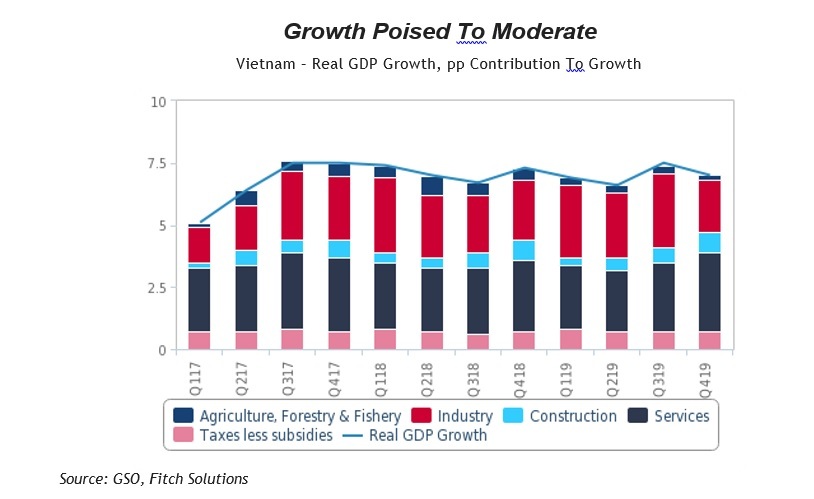 |
Yhe easing of growth in the final quarter was mainly due to weakness in the industrial sector, which saw growth ease to 7.3% y-o- y in Q419, from 10.4% y-o-y in Q319. This saw the industrial sector’s growth contribution fall to 2.1pp, from 3.0pp in Q319.
Growth of the construction sector picked up to 10.3% y-o-y in Q419, from 9.0% y-o-y in Q319, and contributed 0.8pp to growth in Q419. Services sector growth strengthened to 8.1% y-o-y in Q419, from an upwardly revised 7.3% y-o-y in Q319, which saw its growth contribution increase to 3.2pp, from 2.8pp over the same period.
The stronger services growth was mainly driven by retail, transport and warehousing, hotels and restaurants, and financial services. Finally, droughts weighed on crop output, while the outbreak of African swine fever, which has affected all 63 provinces in Vietnam, and Avian Flu in two provinces dragged on livestock production.
Accordingly, growth of the agriculture, forestry, and fishery sector slowed to 1.6% y-o-y in Q419, from 2.0% y-o-y in Q319 and contributed 0.2pp to growth in Q419, versus 0.3pp in Q319.
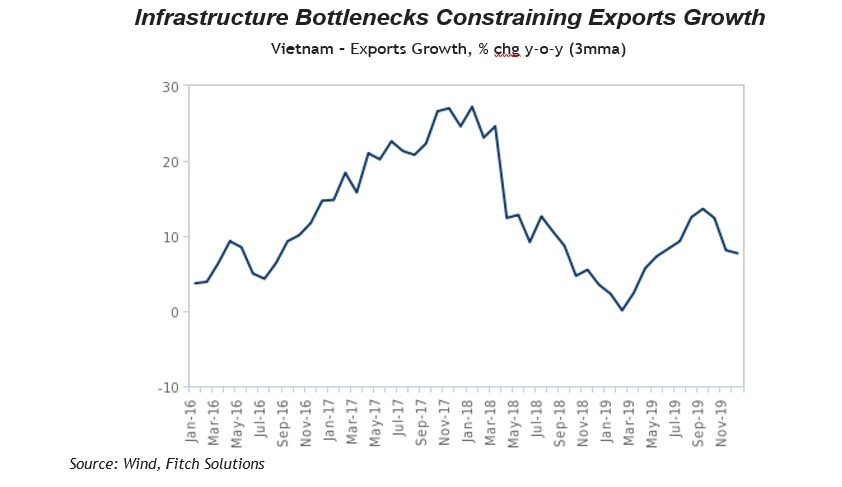 |
Transport and logistical infrastructure and human capital bottlenecks will continue to weigh on growth of the manufacturing sector, which accounts for around 16.5% of the Vietnamese economy.
The US-China trade war accelerated the structural shift in low-end electronics manufacturing and textiles manufacturing out of China and into ASEAN, with Vietnam being a major beneficiary.
However, the rush to set up operations and export out of Vietnam has put considerable stress on the existing road and port infrastructure, resulting in severe traffic congestion in and around major cities such as Ho Chi Minh City and Hanoi, and also week-long delays at the ports, according to media reports.
Indeed, exports growth has decelerated since September 2019 (see chart above) and we expect this trend to persist over the coming months.
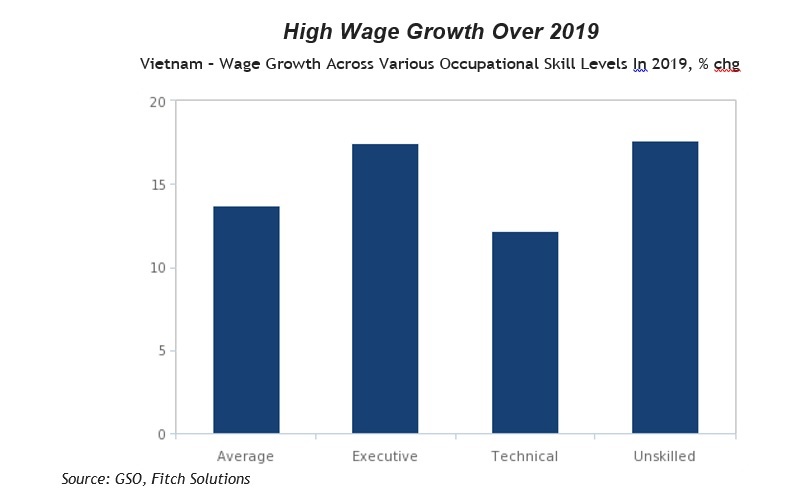 |
The lack of adequate highway connections to the ports has further exacerbated delays. A shortage of qualified labour, as being suggested by high y-o-y wage growth of between 12% and 18% across the occupational skill levels (see chart above), will also weigh on manufacturing growth.
A lack of skilled labour would weigh on productive efficiency through inhibiting the integration of better technology into work processes.
Indeed, Vietnam’s manufacturing production growth slowed sharply to 6.5% y-o-y in November 2019, its lowest level since 2017, from 10.8% y-o-y in October 2019.
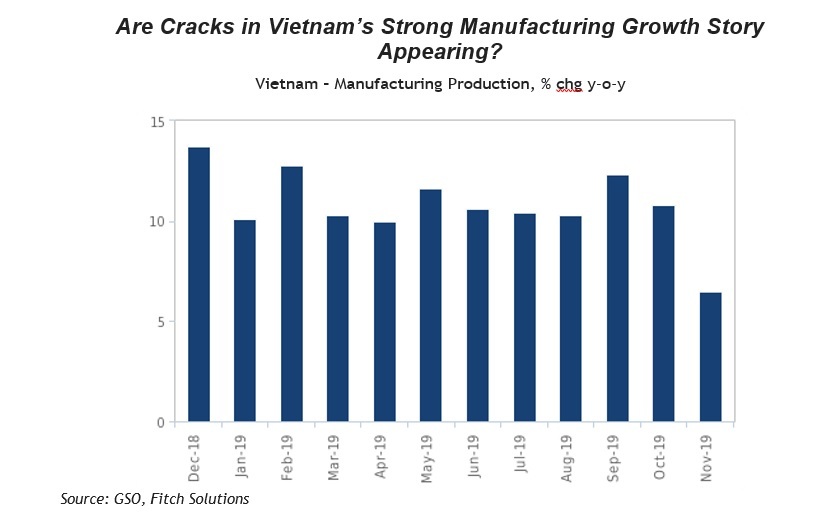 |
Separately, growth of the agriculture sector (14.0% of GDP) will also be under pressure in 2020 due to hydroelectric dam projects upstream of the Mekong River in Laos, as well as diseases such as the African swine fever.
According to a study by the Mekong River Commission in early 2018, the dam projects could reduce Mekong Fish stocks by up to 40%, in addition to causing a 97% reduction in sediment flowing downstream, adversely impacting soil fertility and agriculture.
Separately, the African swine fever has affected all 63 provinces in Vietnam and has reduced the country’s hog herd by 25.5% y-o-y in December 2019. The spread of the disease across the rest of Asia will further inhibit Vietnamese farmers’ ability to rebuild their hog herd, and thus informs our view for agriculture growth to remain subdued.
That said, stronger growth in construction (5.9% of GDP) and services (41.6% of GDP) will partially offset the slowdown. The Vietnamese authorities aim to build 900km more highway roads by 2021, almost doubling the 1000km at present, and the pursuit of this goal will support construction activity.
In particular, progress on the construction of the North-South Highway, which began in September 2019 and is expected to be completed by 2021, will be a key project supporting the construction sector. Upside risks to construction growth should construction on the proposed $55.8bn North-South Express Rail indeed begin in 2020 as the government has currently planned.
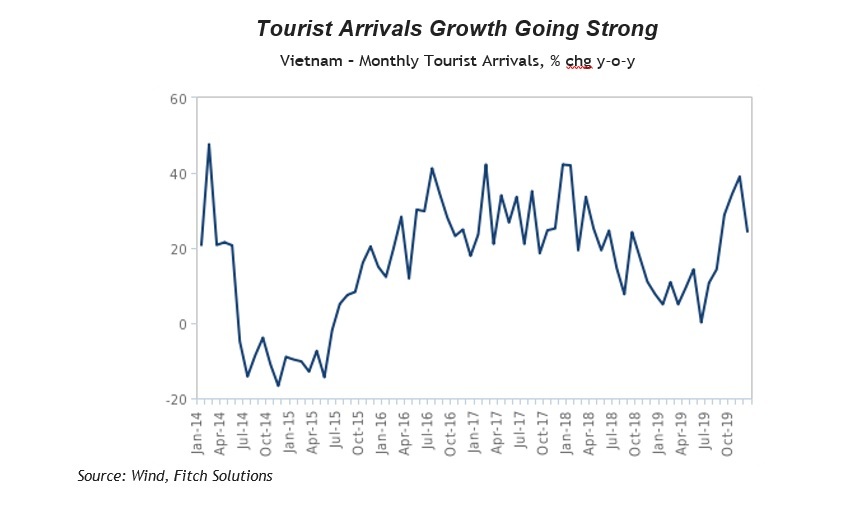 |
Services growth is expected to be underpinned by four key sub-sectors. A strong increase in real wages (even if inflation continues to print around 5-6% over 2020, similar to the December 2019 reading of 5.2% y-o-y), in part driven by skills shortage would support a continued rise of Vietnam’s middle class.
This together with the ongoing trend of robust tourist arrival growth, bodes well for further growth strengthening in retail as well as hospitality services. Indeed, retail sales growth has been relatively stable above 10% over the past three years, growing by an average of 11.7% y-o-y over the period.
The influx of companies to Vietnam to circumvent the US’ tariffs on China will also support growth of transport and warehousing services, especially with the shortage of such services likely pushing up prices and profitability in this sub-sector. Finally, despite a likely (slight) softening of economic growth in 2020, still-robust economic activity will continue to support growth of financial services.
Completion (or possibly even partial completion) of infrastructure construction projects could help to ease existing bottlenecks which are restricting growth in the manufacturing sector.
Combined with a chance of Vietnam ratifying the EU-Vietnam Free Trade Agreement early in 2020, the deceleration in manufacturing sector growth could be less than we expect.
The myriad of tailwinds we have highlighted could also see services sector growth come in stronger than we expect, pushing headline growth higher.
Q. Khuyen

Economists warn GDP growth target a challenge
Vietnam's economy experienced good economic results in 2019, but it will be a challenge to repeat the strong growth this year.
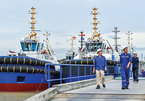
Growth prerequisites in place
Mr. Ousmane Dione, World Bank Country Director for Vietnam, discusses the growth in Vietnam's economy in 2019 and the prospects for 2020.
 According to Fitch Solutions, its 2020 real GDP growth forecast for Vietnam is maintained at 6.8%.
According to Fitch Solutions, its 2020 real GDP growth forecast for Vietnam is maintained at 6.8%.